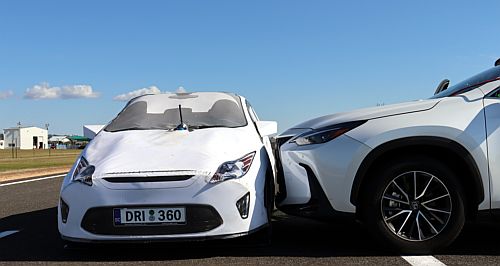ANCAP readies stricter testing

WHILE it was initially expected that ANCAP would introduce its stricter testing protocols from January 1, the safety body says promised changes are still in the pipeline, with the first vehicle to be tested to the new standard expected to be announced from September.
Late last year, ANCAP Safety said it will be adding several new and updated tests and assessments to its star rating regime, focused on strengthening criteria related to vehicle-to-motorcycle collision avoidance, child presence detection and vehicle submergence.
ANCAP indicated that the start of each new protocol window was generally slow. For example, with the 2020 step-change, it was not until September 2020 that the first rating was published to those updated protocols. ANCAP has advised it expects to see similar timing for release of its first rating to the 2023 criteria.
ANCAP Safety said the changes aim to incentivise a continued high level of safety offered to car buyers in Australia and says similar protocols will be implemented by EuroNCAP for cars sold in European markets.
The changes form part of ANCAP and EuroNCAP’s regular regime enhancements which encourage continual safety improvements every few years.
For 2023, Motorcycle Detecting Autonomous Emergency Braking is a further refinement of existing AEB more sensitive to, and capable of recognising and reacting to potential collision scenarios between a motorcycle and a car.
Child Presence Detection is a safety system designed to assist drivers or parents in detecting the presence of children in vehicles, providing an alarm or notification if any child is unknowingly left behind unattended in a vehicle.
Vehicle Submergence Assistance is a system that allows windows and doors to be opened after a vehicle is submerged in floods for example, the sea or rivers. First responders often have difficulty gaining access to vehicles in such situations.
ANCAP Safety will also enhance several existing assessment areas, including:
- the introduction of a 8.00 point penalty compared with the current 4.00 point penalty for vehicle-to-vehicle crash compatibility
- a 10 per cent increase to the star rating thresholds for Vulnerable Road User Protection
- a reassessment of direct driver monitoring systems to manage driver inattention and fatigue, and
- an expansion of autonomous emergency braking test scenarios to include additional night-time tests and child pedestrian avoidance tests when a vehicle is in reverse.
Discussing the introduction of stricter test protocols last year, ANCAP Safety chief executive officer, Carla Hoorweg, said it is important that vehicle safety improvements continually broaden to provide the best possible protection to vehicle occupants and other road users.
“Our 2023 requirements build upon our existing criteria to promote further vehicle safety improvements and address some of the ongoing challenges on our roads,” she said.
“Vehicles, and the safety technologies within them, are continuing to evolve, and our test criteria are too. Physical protection in a crash, and the ability to actively avoid a crash are both essential elements to achieve a high ANCAP safety rating, and this approach will continue from 2023.”
Ms Hoorweg said the requirements set for each star rating level are designed to encourage vehicles that provide a good balance of passive safety – how well a vehicle will protect you and your occupants if you have a crash, and active safety – the ability of a vehicle to prevent or minimise the outcomes of a crash through active collision avoidance systems.
“ANCAP safety ratings are designed to ensure new car buyers and the road users they interact with are offered the safest vehicles and newest technologies. We encourage all vehicle purchasers to choose a vehicle with the highest ANCAP safety rating possible and the latest date stamp. It could save your life, or the lives of those closest to you,” she concluded.